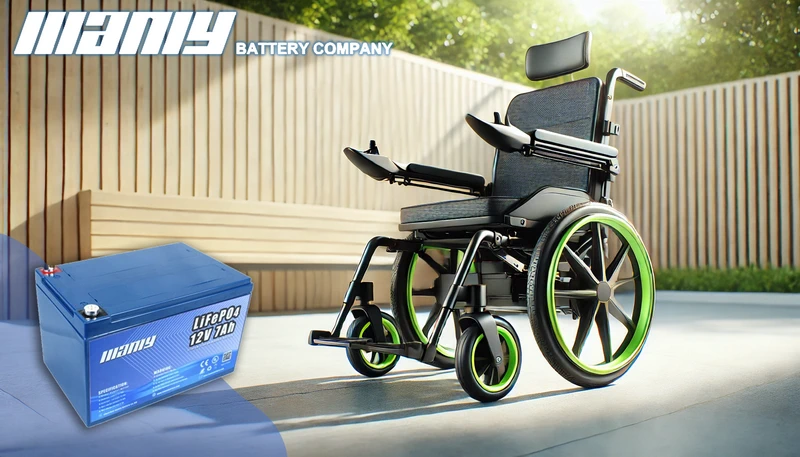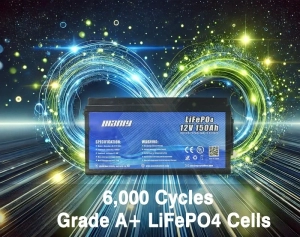Tous les fauteuils roulants électriques ont-ils des batteries au lithium ?
Table des matières
- Tous les fauteuils roulants électriques ont-ils des batteries au lithium ?
- Types de batteries utilisées dans les fauteuils roulants électriques
- Avantages des batteries au lithium pour fauteuils roulants
- Défis liés aux batteries au lithium pour fauteuils roulants
- Stratégies efficaces d’entretien et de remplacement des batteries de fauteuils roulants
- L’avenir de la technologie des batteries pour fauteuils roulants : tendances et innovations
- Conclusion
- En savoir plus sur la batterie

Types de batteries utilisées dans les fauteuils roulants électriques
When selecting an electric wheelchair, one of the most crucial components to consider is the battery type. The battery not only determines how far the wheelchair can travel on a single charge but also impacts the overall weight, maintenance, and usability of the wheelchair. In this section, we'll explore the different types of batteries commonly used in electric wheelchairs: 12v wheelchair battery, Gel, AGM, and lithium wheelchair batteries.Batterie pour fauteuil roulant 12 V
The Batterie 12 V pour fauteuil roulantest un élément essentiel dans de nombreux modèles de fauteuils roulants électriques. Ce type de batterie est apprécié pour sa fiabilité et ses performances constantes. En règle générale, deux batteries de 12 volts sont connectées en série pour fournir un système de 24 volts, essentiel pour les besoins électriques de la plupart des fauteuils roulants. Ces batteries sont souvent de type plomb-acide, connues pour leur durabilité et leur rentabilité.Piles au gel
Gel batteries are a type of sealed lead-acid battery, but with a twist: they use a gelified electrolyte. This gel composition helps prevent leaks and is less prone to damage if the battery casing is compromised. Gel batteries are also more stable, can handle lower temperatures, and are less likely to sulfate compared to their standard lead-acid counterparts. For wheelchair users, this means less maintenance and a reduced risk of unexpected power loss.Batteries AGM (à tapis de verre absorbé)
AGM batteries represent a subgroup of lead-acid batteries where the electrolyte is absorbed into a fiberglass mat. This design makes the batteries spill-proof and provides superior performance in terms of power output and charge cycles. AGM batteries are more efficient at charging and discharging than traditional lead-acid batteries, making them a preferred choice for users who need a reliable power source that can handle frequent charging cycles without deteriorating too quickly.Piles au lithium pour fauteuils roulants
Lithium wheelchair batteries are becoming increasingly popular due to their lightweight and high efficiency. These batteries can charge faster and last longer than lead-acid batteries, providing more range and a lighter weight, which makes the wheelchair easier to transport and maneuver. Moreover, lithium batteries do not require the same level of maintenance as lead-acid batteries, such as regular watering. However, they are usually more expensive upfront and may require special care when charging to ensure longevity.Spécifications techniques
Each battery type comes with its own set of specifications. 12v wheelchair batteries typically provide a solid balance of performance and affordability but may be heavier and require more frequent replacement. Gel and AGM batteries offer better performance in terms of longevity and maintenance, with AGM usually being the more robust option in cold weather. Lithium wheelchair batteries, while the most expensive, offer the highest energy density, resulting in lighter weight and longer life spans, making them a worthwhile investment for active users.In summary, the choice of battery in an electric wheelchair impacts not only the wheelchair's performance but also its operational costs and user experience. Whether you opt for the economical 12v wheelchair battery, the durable Gel or AGM, or the high-performing lithium wheelchair batteries, understanding these options will help you make an informed decision tailored to your specific needs.Avantages des batteries au lithium pour fauteuils roulants
Lithium batteries are revolutionizing the mobility industry, particularly in the realm of electric wheelchairs. Known for their efficiency and longevity, lithium wheelchair batteries offer significant advantages over traditional battery technologies like lead-acid. This chapter explores why these batteries are becoming the preferred choice for those seeking dependable, lightweight, and environmentally friendly options in electric wheelchairs.Longévité et fiabilité
One of the standout benefits of lithium wheelchair batteries is their longevity. Unlike traditional batteries, which may require frequent replacements, lithium batteries can last significantly longer. They have a higher number of charge cycles, often up to 1000-2000 full charge cycles before their capacity begins to degrade. This means that a lithium battery could potentially last for several years without needing a replacement, making it a cost-effective solution in the long run.Additionally, lithium batteries maintain their charge efficiency better than their counterparts. They can discharge up to 80-90% of their capacity without significant loss in power output, ensuring that the wheelchair operates at a high performance for longer periods. This reliability is crucial for users who depend on their electric wheelchairs for daily mobility.Avantages du poids
The weight of the battery is a critical factor in the design and functionality of electric wheelchairs. Lithium wheelchair batteries are up to 30% lighter than traditional lead-acid batteries. This reduction in weight contributes to a lighter wheelchair, which is easier to maneuver and transport. For users, this means enhanced mobility and less physical strain, particularly when loading and unloading the wheelchair from vehicles or navigating through tight spaces.Impact environnemental
Environmental sustainability is increasingly becoming a priority, and lithium batteries score well on this front too. They are more environmentally friendly than lead-acid batteries because they contain no hazardous lead and have a lower risk of acid leaks. Moreover, the longer lifespan of lithium batteries reduces the frequency of battery replacements and the associated environmental burden of waste and recycling.Préférence croissante dans le secteur de la mobilité
The shift towards lithium technology in the mobility sector is driven not only by the benefits mentioned above but also by broader technological advancements and regulatory factors. Innovations in lithium battery technology have led to safer, more efficient batteries that meet the rigorous demands of electric wheelchair users. Regulatory pushes for greener technologies also play a role, as lithium batteries align better with environmental guidelines compared to lead-acid batteries.In conclusion, lithium wheelchair batteries represent a superior choice for modern electric wheelchairs, driven by their long life, lightweight characteristics, and minimal environmental impact. As technology continues to advance, we can expect these batteries to play an even greater role in enhancing the independence and quality of life for individuals relying on electric mobility aids. The ongoing development and adoption of lithium batteries are set to transform the electric wheelchair market, making it more accessible, sustainable, and user-friendly.Défis liés aux batteries au lithium pour fauteuils roulants
While batteries de fauteuil roulant au lithiumoffrent de nombreux avantages, ils comportent également leur propre ensemble de défis qui peuvent avoir un impact sur le choix et la satisfaction des utilisateurs. Ce chapitre examine les limites et les complications associées à ces batteries, en explorant des aspects tels que le coût, la compatibilité et les scénarios dans lesquels des types de batteries alternatifs pourraient être plus adaptés.Problèmes de coûts
One of the primary deterrents for many users considering batteries de fauteuil roulant au lithium is the initial cost. Lithium batteries are generally more expensive than their lead-acid or gel counterparts. This higher upfront cost can be prohibitive for individuals or healthcare facilities with limited budgets. Although the long-term benefits, such as fewer replacements and lower maintenance, can offset the initial expense, the initial investment remains a significant barrier for widespread adoption.Moreover, the maintenance and replacement of lithium batteries, though less frequent, can also be more costly. Specialized equipment and knowledge are required to safely handle and dispose of lithium batteries, adding to the overall cost of ownership.Problèmes de compatibilité
Compatibility is another significant challenge with the adoption of lithium batteries in electric wheelchairs. Many existing wheelchair models are designed to operate optimally with traditional battery types, such as lead-acid. Retrofitting these models to accommodate batteries à lithiumpeut nécessiter des modifications importantes, non seulement dans le boîtier de la batterie, mais également dans les systèmes de contrôle électronique pour gérer différentes tensions et courants. Cela peut compliquer la transition vers la technologie au lithium, en particulier pour les utilisateurs qui ne sont pas prêts à acheter de nouveaux fauteuils roulants mais qui cherchent à mettre à niveau leurs systèmes de batteries existants.Adéquation dans certains scénarios
While lithium batteries excel in many use-cases due to their lightweight and high-energy density, there are scenarios where other types of batteries might be more suitable. For example, in extremely cold environments, lithium batteries can underperform as low temperatures can affect their chemical reactions, leading to reduced power output and efficiency. In such cases, gel or AGM (Absorbent Glass Mat) batteries, which are less susceptible to cold temperatures, might be a better choice.In addition, for users who require only minimal use of their electric wheelchair or for those who prioritize certain performance characteristics such as extreme durability under rough conditions, the cost-benefit ratio of lithium may not be as favorable. Here, the more robust nature of traditional batteries could be deemed more appropriate despite their heavier weight and lower efficiency.Stratégies efficaces d’entretien et de remplacement des batteries de fauteuils roulants
Maintaining and replacing the batteries of an electric wheelchair are crucial for ensuring optimal performance and longevity of your mobility aid. This chapter provides practical advice and tips on how to care for and when to replace the batteries in your electric wheelchair, focusing on maximizing their lifespan and ensuring continuous, reliable mobility.Entretenir différents types de batteries de fauteuils roulants
The maintenance needs of wheelchair batteries can vary significantly depending on the type of battery used. Gel batteries, AGM batteries, and lithium wheelchair batteries all have different care requirements:- Piles au gel require very little maintenance as they are sealed and do not need watering. However, it's crucial to keep them charged and avoid completely depleting the battery charge, as this can significantly shorten their lifespan.
- Batteries AGM (Absorbent Glass Mat) also do not need additional water and are more resistant to vibrations than gel batteries. They should be kept fully charged and stored in a cool, dry place when not in use to prevent sulfation, which can degrade the battery's capacity.
- Batteries au lithium pour fauteuils roulants are the most maintenance-friendly among all types, with a high energy density and no memory effect, meaning they don’t require complete discharge before recharging. Nevertheless, it's important to use a compatible charger and avoid exposing them to extreme temperatures, as heat can cause lithium batteries to degrade faster.
Choisir et remplacer les batteries d'un fauteuil roulant
When it comes time to replace your wheelchair’s battery, several factors should be considered to choose the right battery:- Compatibilité de la batterie: Ensure that the replacement battery is compatible with your wheelchair model. Voltage and capacity should match the manufacturer's specifications to avoid any issues with performance or damage to the wheelchair's motor or electronics.
- Marque et qualité: Optez pour des batteries de haute qualité provenant de fabricants réputés. Les alternatives moins chères peuvent permettre d'économiser de l'argent au départ, mais offrent généralement des durées de vie plus courtes et des performances moins fiables, ce qui conduit à des remplacements plus fréquents.
- Type de batterie: Considérez le type de batterie qui correspond le mieux à vos besoins. Les batteries au lithium, bien que plus chères, offrent une durée de vie plus longue et nécessitent une recharge moins fréquente. Si les contraintes budgétaires vous préoccupent, les batteries gel ou AGM peuvent être de bonnes alternatives.
- Garantie et assistance: Vérifiez la garantie offerte avec la batterie. Une période de garantie plus longue est souvent le signe d’une batterie de meilleure qualité. De plus, acheter auprès d'un fournisseur offrant un bon support client peut être bénéfique en cas de problèmes pendant la durée de vie de la batterie.
- Éteindre le fauteuil roulant et retirer les connexions de la batterie.
- Retirez l'ancienne batterie en toute sécurité et jetez-la conformément aux réglementations locales, car les batteries contiennent des matériaux qui peuvent être nocifs pour l'environnement.
- Installez la nouvelle batterie, en vous assurant que toutes les connexions sont sécurisées et correctes.
L’avenir de la technologie des batteries pour fauteuils roulants : tendances et innovations
As we move forward, the field of battery technology continues to evolve, offering new possibilities and improvements for electric wheelchair users. This chapter explores the significant technological advancements in the battery sector and anticipates future trends that may redefine mobility for individuals relying on electric wheelchairs.Avancées technologiques dans la technologie des batteries
In recent years, lithium wheelchair batteries have made a notable impact due to their efficiency and longevity. Unlike traditional 12v wheelchair battery systems or other chemistries like Gel and AGM, lithium batteries offer a superior energy-to-weight ratio, which is crucial for mobility applications. They charge faster, last longer, and require less frequent replacement, making them a highly beneficial investment for wheelchair users.Beyond lithium, researchers are exploring other innovative battery technologies. Solid-state batteries, for instance, promise even greater safety and energy density. These batteries replace the liquid or gel electrolytes with a solid counterpart that is less prone to leaking and can withstand higher temperatures without degrading. Such advancements could further improve the safety and performance of wheelchair batteries.Prédire les tendances futures des batteries pour fauteuils roulants
Looking ahead, the future of wheelchair batteries is likely to be shaped by several key factors:- Durabilité: Alors que l’accent mondial mis sur l’impact environnemental augmente, on constate une tendance vers des technologies de batteries plus durables. Les innovations telles que les programmes de recyclage des batteries et le développement de composants de batteries biodégradables gagnent du terrain. Ces efforts visent non seulement à réduire l’empreinte écologique, mais également à renforcer l’économie circulaire au sein de l’industrie des batteries.
- Intégration avec les énergies renouvelables: Avec l'essor des sources d'énergie renouvelables, les futurs fauteuils roulants électriques pourraient intégrer des panneaux solaires ou d'autres technologies de récupération d'énergie pour prolonger la durée de vie de la batterie et réduire la dépendance aux méthodes de recharge traditionnelles. Cette intégration pourrait être particulièrement bénéfique pour améliorer l’autonomie des utilisateurs de fauteuils roulants, permettant une plus grande mobilité sans avoir besoin de recharger fréquemment.
- Systèmes de gestion de batterie intelligents (BMS): Les progrès de l'électronique et des logiciels ont conduit au développement de BMS plus intelligents qui optimisent la durée de vie et les performances de la batterie. Les futurs fauteuils roulants pourraient utiliser un BMS capable de prédire l’état de la batterie et les besoins d’entretien, d’ajuster la consommation d’énergie en fonction des habitudes de déplacement et d’améliorer l’efficacité globale de la batterie.
- Personnalisation et conception spécifique à l'utilisateur: À mesure que la technologie devient plus adaptable, les futurs systèmes de batteries pourraient offrir davantage d’options de personnalisation. Les batteries pourraient être conçues pour répondre aux besoins spécifiques des utilisateurs individuels, en tenant compte de facteurs tels que l'utilisation quotidienne typique, les exigences de poids et même les conditions climatiques.
Conclusion
As we have seen, the choice of battery not only affects the performance and efficiency of electric wheelchairs but also influences the user's independence and quality of life. The ongoing advancements in battery technology, particularly the shift towards more sustainable and high-performing options like lithium wheelchair batteries, promise to further enhance these devices. With innovations such as smart battery management systems and integration with renewable energy sources on the horizon, the future of wheelchair batteries looks bright. Users can look forward to wheelchairs that are more powerful, durable, and environmentally friendly, transforming mobility and accessibility for many.




















